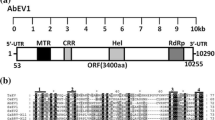Abstract
The complete genome of a putative new endornavirus infecting hot peppers (Capsicum annuum) was determined to be 14,729 nt in size, including 12 cytosines at the 3′ end. The hot pepper-infecting virus has the highest nucleotide sequence similarity (94 % query cover and 72 % identity) to bell pepper endornavirus (BPEV) isolated from the cultivar Yolo Wonder in the USA (GenBank accession no. JN019858). The putative single, large open reading frame encodes a 4,884-amino-acid-long polyprotein that contains four putative functional domains: a viral methyltransferase, a viral RNA helicase, a glycosyltransferase, and an RNA-dependent RNA polymerase. A phylogenetic tree based on whole polyprotein sequences confirmed the close evolutionary relationship of the studied endornavirus to BPEV. The hot pepper-infecting virus also has a nick at nt position 975. Taken together, these results suggest that this virus belongs to a new species in the genus Endornavirus (family Endornaviridae), for which the name hot pepper endornavirus (HPEV) is proposed.


Similar content being viewed by others
References
Debat HJ, Grabiele M, Aguilera PM, Bubillo R, Zapata PD, Marti DA, Ducasse DA (2014) The complete genome of a putative endornavirus identified in yerba mate (Ilex paraguariensis St. Hil.). Virus Genes 49(2):348–350
Espach Y, Maree HJ, Burger JT (2012) Complete genome of a novel endornavirus assembled from next-generation sequence data. J Virol 86(23):13142
Fukuhara T, Koga R, Aoki N, Yuki C, Yamamoto N, Oyama N, Udagawa T, Horiuchi H, Miyazaki S, Higashi Y, Takeshita M, Ikeda K, Arakawa M, Matsumoto N, Moriyama H (2006) The wide distribution of endornaviruses, large double-stranded RNA replicons with plasmid-like properties. Arch Virol 151(5):995–1002
Fukuhara T, Moriyama H, Nitta T (1995) The unusual structure of a novel RNA replicon in rice. J Biol Chem 270(30):18147–18149
Marchler-Bauer A, Lu S, Anderson JB, Chitsaz F, Derbyshire MK, DeWeese-Scott C, Fong JH, Geer LY, Geer RC, Gonzales NR, Gwadz M, Hurwitz DI, Jackson JD, Ke Z, Lanczycki CJ, Lu F, Marchler GH, Mullokandov M, Omelchenko MV, Robertson CL, Song JS, Thanki N, Yamashita RA, Zhang D, Zhang N, Zheng C, Bryant SH (2011) CDD: a Conserved Domain Database for the functional annotation of proteins. Nucleic Acids Res 39(1):D225–D229
Okada R, Kiyota E, Moriyama H, Toshiyuki F, Valverde RA (2014) A new endornavirus species infecting Malabar spinach (Basella alba L.). Arch Virol 159(4):807–809
Okada R, Kiyota E, Sabanadzovic S, Moriyama H, Fukuhara T, Saha P, Roossinck MJ, Severin A, Valverde RA (2011) Bell pepper endornavirus: molecular and biological properties, and occurrence in the genus Capsicum. J Gen Virol 92:2664–2673
Okada R, Yong CK, Valverde RA, Sabanadzovic S, Aoki N, Hotate S, Kiyota E, Moriyama H, Fukuhara T (2013) Molecular characterization of two evolutionarily distinct endornaviruses co-infecting common bean (Phaseolus vulgaris). J Gen Virol 94:220–229
Roossinck MJ, Sabanadzovic S, Okada R, Valverde RA (2011) The remarkable evolutionary history of endornaviruses. J Gen Virol 92:2674–2678
Sela N, Luria N, Dombrovsky A (2012) Genome assembly of bell pepper Endornavirus from small RNA. J Virol 86(14):7721
Villanueva F, Sabanadzovic S, Valverde RA, Navas-Castillo J (2012) Complete genome sequence of a double-stranded RNA virus from avocado. J Virol 86(2):1282–1283
Acknowledgments
This research was undertaken with the support of the Cooperative Research Program for Agriculture Science & Technology Development (project no. PJ01007703), Rural Development Administration, and the Animal and Plant Quarantine Agency (QIA, project code no. Z-1542051-2013-15-01), Ministry of Agriculture, Republic of Korea.
Author information
Authors and Affiliations
Corresponding authors
Additional information
S. Lim and K. H. Kim contributed equally to this study.
Electronic supplementary material
Below is the link to the electronic supplementary material.
Rights and permissions
About this article
Cite this article
Lim, S., Kim, K.H., Zhao, F. et al. Complete genome sequence of a novel endornavirus isolated from hot pepper. Arch Virol 160, 3153–3156 (2015). https://doi.org/10.1007/s00705-015-2616-7
Received:
Accepted:
Published:
Issue Date:
DOI: https://doi.org/10.1007/s00705-015-2616-7




